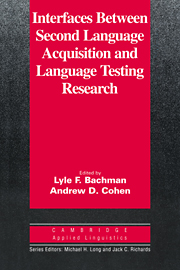Book contents
- Frontmatter
- Contents
- List of contributors
- Series editors' preface
- Preface
- Chapter 1 Language testing – SLA interfaces: An update
- Chapter 2 Construct definition and validity inquiry in SLA research
- Chapter 3 Research on interlanguage variation: Implications for language testing
- Chapter 4 Strategies and processes in test taking and SLA
- Chapter 5 Describing language development? Rating scales and SLA
- Chapter 6 Testing methods in context-based second language research
- Chapter 7 How can language testing and SLA benefit from each other? The case of discourse
- Appendix: Language testing – SLA research interfaces
- Index
Chapter 1 - Language testing – SLA interfaces: An update
Published online by Cambridge University Press: 05 October 2012
- Frontmatter
- Contents
- List of contributors
- Series editors' preface
- Preface
- Chapter 1 Language testing – SLA interfaces: An update
- Chapter 2 Construct definition and validity inquiry in SLA research
- Chapter 3 Research on interlanguage variation: Implications for language testing
- Chapter 4 Strategies and processes in test taking and SLA
- Chapter 5 Describing language development? Rating scales and SLA
- Chapter 6 Testing methods in context-based second language research
- Chapter 7 How can language testing and SLA benefit from each other? The case of discourse
- Appendix: Language testing – SLA research interfaces
- Index
Summary
For some years, language testing (LT) research and second language acquisition (SLA) research have largely been viewed as distinct areas of inquiry in applied linguistics. Since the late 1980s, however, we have seen an increasing number of studies in which these two subfields of applied linguistics come together, both in terms of the substantive issues being investigated and the methodological approaches used. An overview of the areas of overlap, or interfaces, was provided in Bachman (1989; reprinted as an appendix in this volume). There have been many developments in both areas since then, and in this chapter we identify what we see as some of the continuing contrasts – contrasts that we view as natural and healthy outgrowths of the differing interests and foci of LT and SLA research. We then discuss several areas and issues that have been discussed more or less independently by LT and SLA researchers, and that we believe constitute interfaces between these two fields of applied linguistics, briefly illustrating these interfaces with some recent research studies. Finally, we list some of the challenges and questions that we feel suggest areas for future research for both LT and SLA. It is not our purpose to present a comprehensive review of the research literature in LT and SLA. Rather, we would like to suggest a conceptual framework and approach for building more extensive and substantial interfaces between LT and SLA research in the future, and point to some directions for addressing many of the complex and thorny issues that have, in the past, generally been dealt with in a rather compartmentalized manner by LT and SLA researchers.
- Type
- Chapter
- Information
- Publisher: Cambridge University PressPrint publication year: 1999
- 1
- Cited by



